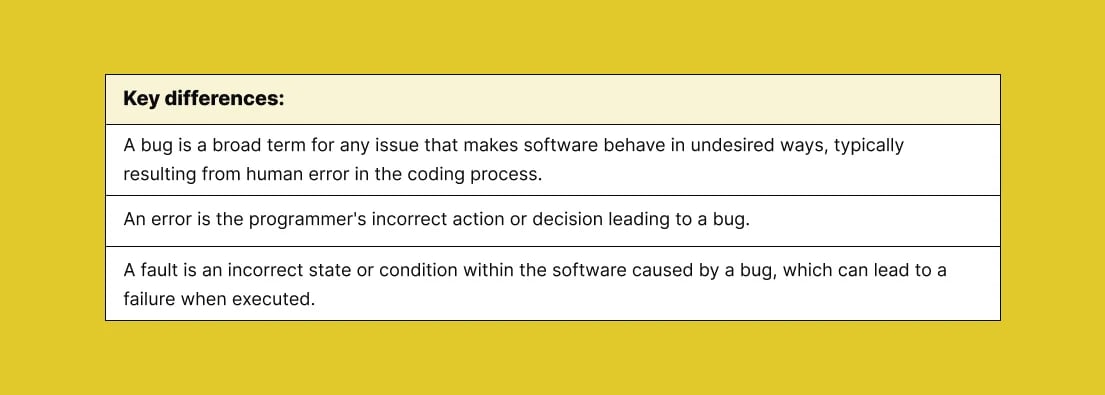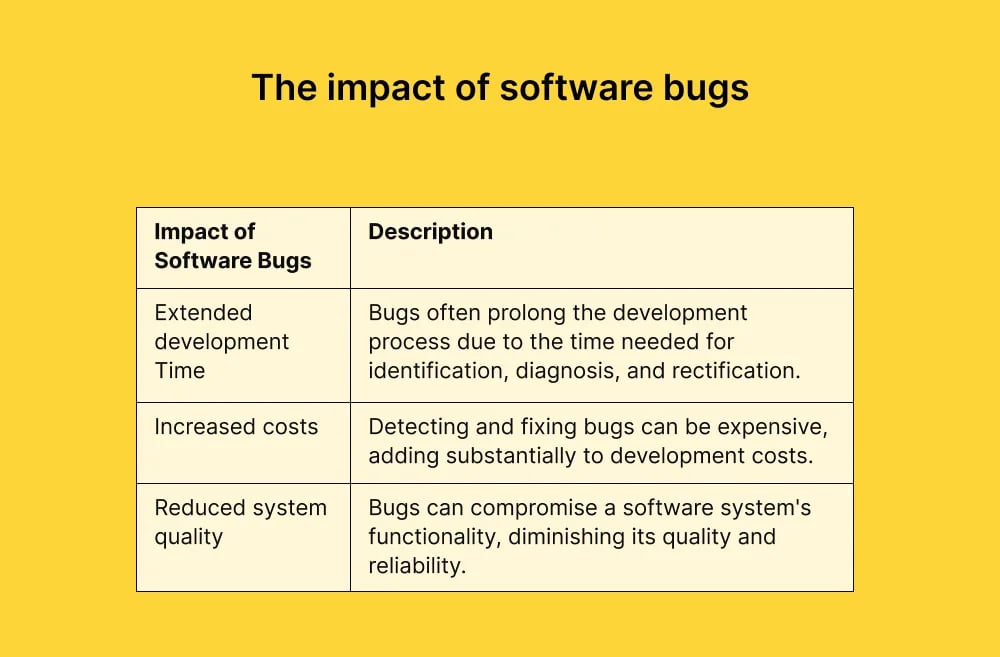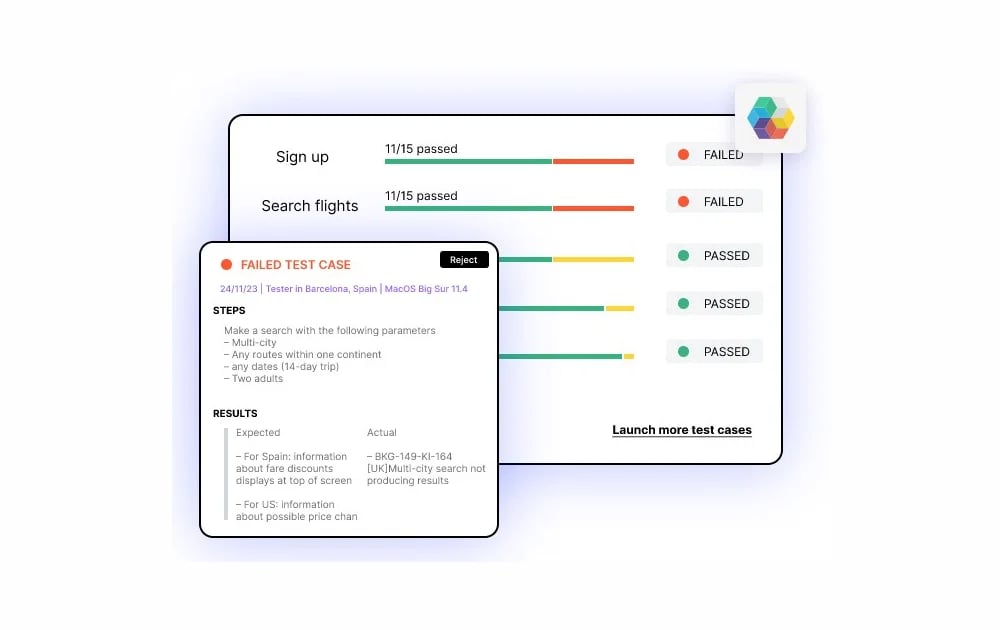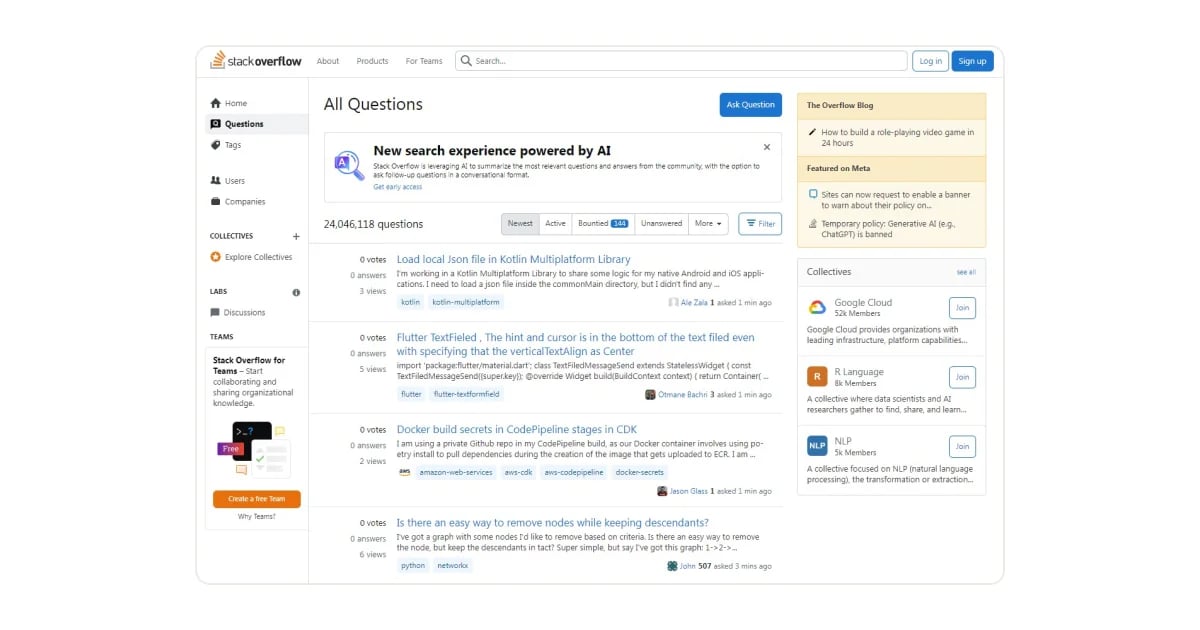The most common software bugs and ways to reduce instances
Stack Overflow has been swooping to the rescue of all types of developers since its founding in 2008. Since then, developers have asked millions upon millions of different questions within all areas of development. But what are the kinds of problems developers are forced to turn to Stack Overflow for? We picked some of the most common software bugs and how to manage them. Let's begin!
What is a software bug?
A software bug is an error, flaw, or fault in a computer program or system, leading to wrong or unforeseen outcomes or causing the program to act in ways it wasn't designed to.
Differences between bugs, errors, and faults
Understanding the differences between bugs, errors, and faults is crucial in software development and testing. So let’s cover them.
1. Bugs
- Definition: As mentioned above, a bug is essentially a problem in the code that makes the software operate improperly.
- Characteristics: Bugs are usually the result of human error during the software development process, including mistakes in code, logic errors, or improper handling of data.
- Example: A bug could be a piece of code that incorrectly calculates a value due to a wrong arithmetic operation.
2. Errors
- Definition: An error refers to a mistake made by a programmer that leads to incorrect, unexpected, or unintended behavior in the software. The term is often used interchangeably with "bug." Still, it can also specifically refer to the mistake itself rather than the manifestation of the error.
- Characteristics: Errors are the root cause behind the problem in the code. They represent the actual wrong decisions or missteps made by the programmer.
- Example: Writing x = y + 2 instead of x = y - 2 is an error. The error leads to a bug if the software's intended functionality is subtracting rather than adding.
3. Faults
- Definition: A fault, often called a defect, manifests a software error. It's essentially the incorrect state within a software system caused by a bug.
- Characteristics: Faults result from errors, potentially leading to failures if triggered. They represent the condition within the software that is incorrect.
- Example: If an error in the code sets a variable to an incorrect value, the existence of this incorrect value (the state) in the system is the fault.

8 Categories of software bugs and how to manage them
1. Performance bugs: the invisible slowdown
Performance bugs often lurk unnoticed, affecting software's stability, speed, and response time. They're tricky to handle due to their subtle nature. These bugs don't typically cause crashes or incorrect results, making them hard to detect through standard output checks.
Managing performance bugs
- Use performance monitoring tools and set alerts for minimum acceptable response times.
- Implement load tests for critical performance areas to ensure system stability against new changes.
2. Functional bugs: misleading simplicity
As straightforward as they sound, functional bugs disrupt the expected behavior of software functionalities. For example:
- Non-responsive buttons or features.
- Incorrectly functioning components in apps or websites.
Tackling functional bugs
- Employ extensive testing methods, including unit, integration, and automated functional tests.
- Emphasize manual regression testing for frequently changing software parts.
3. Syntax errors: the devil in the details
Incorrect command formations, such as grammatical mistakes or misspelled words in code, cause syntax errors. For example, simple discrepancies like missing quotation marks can have significant impacts.
Preventing syntax errors
- Ensure proper syntax through learning and code editors.
- Enable debugging during development to catch errors early.
4. Logic bugs: correct but incorrect
Logic bugs occur when code executes properly but fails to behave as intended, often due to flawed logic or structure.
Resolving logic bugs
- Use debugging tools and validate variable values thoroughly to pinpoint and fix logic errors.
5. System-level integration bugs: the inter-system puzzle
These bugs arise from errors in the interaction between different subsystems. They can be complex due to the involvement of multiple software systems.
Managing integration bugs
- Conduct thorough integration testing to identify and fix these bugs early in the development process.
6. Usability bugs: the user experience dilemma
Usability bugs complicate the user experience, making software challenging to navigate or understand. To detect them, you should observe real users interacting with the software to identify usability issues.
Fixing usability bugs
- Focus on sound design and prototyping, followed by usability studies and user research.
- Iterative design improvements can prevent costly rewrites later.
7. Security bugs: guarding against intruders
Security bugs create vulnerabilities, allowing unauthorized access or control of systems.
Addressing security bugs
- Enhance development processes, focusing on security architecture and rigorous security testing.
- Conduct penetration tests to ensure compliance with security requirements.
8. Compatibility bugs: the cross-platform challenge
Compatibility bugs affect software performance across different hardware, browsers, and operating systems.
Managing compatibility bugs
- Perform extensive compatibility testing across a wide range of systems and configurations.
- Continuously update test cases to reflect evolving platforms and technologies.
5 Most common software bugs - real-life examples
1. Off-by-one errors
Off-by-one errors occur when a loop iterates one time too many or too few, often due to a mistake in a loop's boundary conditions. This error is common in programming languages like C, C++, and Java that use zero-based indexing. It often happens when a programmer miscounts the iterations of a loop, leading to either an iteration too few (missing the last element) or too many (accessing a non-existent element).
Example
In a loop iterating over an array of 10 elements, using i <= 10 instead of i < 10 causes an off-by-one error, trying to access the 11th element, which doesn't exist. This can lead to incorrect program behavior or crashes due to accessing invalid memory locations.
2. Memory leaks
Memory leaks happen when a computer program incorrectly manages memory allocations, resulting in reduced performance or system crashes. It occurs when a program creates a memory in a heap and forgets to delete it, leading to the memory not being reclaimed. Over time, these leaks can consume a large part of memory, affecting system performance.
Consequences
It can cause an application to run slower and consume more resources. In severe cases, it can lead to application or system crashes due to exhaustion of available memory.
3. Null pointer dereferences
Null pointer dereferences happen when a program attempts to use a null pointer, leading to crashes or unexpected behavior. This issue arises when a pointer expected to point to a valid memory address is null. Attempting to access or manipulate the object it points to causes an error, as the pointer doesn't reference anything.
Example
Trying to access a member of a null object in object-oriented programming - like trying to call a method on a null object reference. As a result, it can lead to program crashes or segmentation faults.
4. Concurrency issues
Concurrency issues occur in environments where multiple processes or threads operate simultaneously, leading to unexpected results. It is common in distributed systems or multi-threaded applications. It also occurs due to improper handling of shared resources, leading to race conditions, deadlocks, or data inconsistencies.
Example
Two threads simultaneously access and modify the same variable without proper synchronization. This can result in data corruption, inconsistent state, or system deadlocks where no progress is possible.
5. Security vulnerabilities
Security vulnerabilities are weaknesses in a system that can be exploited to compromise data integrity, confidentiality, or availability. Common oversights leading to security risks:
- Often, it occurs due to inadequate input validation, buffer overflows, or improper error handling.
- Failure to encrypt sensitive data or the use of outdated libraries can also introduce vulnerabilities.
Example
SQL injection, where unvalidated user input is directly included in a SQL query. This can lead to unauthorized data access, data breaches, and system compromise, severely affecting user privacy and organizational security.
The impact of software bugs
Software bugs can have significant implications for software systems, the businesses relying on them, and their end-users rather than being just minor inconveniences. Here is an overview of the primary impacts of software bugs:

7 Streamlined strategies for efficient software debugging
Debugging can be tedious and time-consuming, but there are several ways to identify and fix errors:
1. Use debugging tools
1. To dissect your code, implement advanced debugging tools like Lightrun, Ghidra, Interactive Disassembler, and Fusion Reactor.2. Consider automated testing tools like Global App Testing for unit testing and streamlining the bug identification process.


2. Implement print statements
Pinpoint the problematic code segment and use print statements to monitor variable values or outputs. This is particularly effective in complex loops, helping you track the flow and pinpoint discrepancies.
3. Emphasize clean code
Approach coding as an art form, aiming for simplicity, clarity, and readability. Clear and well-structured code makes bug detection more manageable. Utilize comments for guidance and reference throughout your code.
4. Use strategic commenting out
Use the commenting feature to temporarily disable code sections, isolating the bug's location.
This versatile technique applies to various bug types, including system-level integration issues.
5. Conduct quality analysis
Leverage code review tools for static code analysis, which is crucial for ensuring software integrity. To preemptively address potential bugs, focus on continuous quality evaluation, especially during the learning phase.
6. Choose the right programming language
The role of programming languages in debugging is significant, as the design and features of a language can significantly influence the ease and effectiveness of the debugging process.
1. Languages with clear, simple syntax (like Python) are easier to debug. Intuitive syntax helps programmers quickly spot mistakes that could lead to bugs.
2. Strongly typed languages (e.g., Java, C#) require explicit variable type declarations, reducing type mismatch errors. Conversely, weakly typed languages (like JavaScript) offer flexibility but can lead to subtle, hard-to-detect bugs.
3. Some languages provide advanced error reporting with detailed messages and specific line numbers, aiding in quick bug identification.
4. The availability and quality of debugging tools differ across languages. Those with comprehensive tools, like IDEs with built-in debuggers (e.g., Visual Studio for C#), enable more efficient debugging.
 5. Some languages include features such as logging, assertions, and error handling, which assist in identifying and isolating code issues.
5. Some languages include features such as logging, assertions, and error handling, which assist in identifying and isolating code issues.
6. The language's paradigm (procedural, object-oriented, functional, etc.) influences debugging. For instance, object-oriented languages allow encapsulation, simplifying bug isolation within specific objects or methods.
7. A larger, active community around a language often means more resources, forums, and libraries, providing solutions and best practices for debugging.
8. Languages allowing concise code can inherently reduce bug likelihood due to fewer lines of code. However, highly abstracted languages may conceal complexities, posing challenges in understanding and debugging certain issues.
7. Take breaks for clarity
Don't underestimate the power of stepping back and taking a break. Programming and debugging can be exhausting. Periodic breaks can refresh your perspective, often leading to breakthroughs in problem-solving.
Integrate Global App Testing in your bug prevention and detection strategy
If you're struggling with finding or fixing software bugs or just need some guidance, Global App Testing can help you out. It's crucial to eliminate these most common software bugs to ensure your software works seamlessly and is well-received by users. Here's how GAT can assist you:
Real-world testing environment:
- Global App Testing allows apps to be tested under diverse real-world conditions, including different devices, operating systems, and network environments.
- This variety helps uncover bugs that may not manifest in a controlled testing environment.
Crowd-sourced testing expertise:
- With a network of 90,000 professional testers worldwide, the platform provides a wide range of expertise and perspectives.
- This diverse testing pool can lead to a more thorough examination and detection of functional, usability, and compatibility bugs.
Rapid and scalable testing:
- The crowd-sourced model allows for rapid deployment of testing resources, making it suitable for agile development environments.
- It can scale to meet the demands of large projects or smaller apps' fast-paced release cycles.
Localization and cultural relevance:
- Testers from different regions can provide insights into localization issues, ensuring the app resonates well with target audiences globally.
- This approach includes testing for cultural relevance, language accuracy, and regional compliance.
Detailed Reporting and Analytics:
- These reports help development teams prioritize and address issues effectively and improve overall software quality.
Thinking about making your software the best it can be? Let's arrange a call with our specialist today!
We can help you test software and fix bugs aligned with your business goals
FAQ
What causes a software bug?
Bugs are often caused by human errors in writing or designing the software. This can include misinterpreting requirements, coding mistakes, incorrect algorithm implementations, or failing to anticipate certain use cases.
What is the importance of debugging in software development?
Debugging is essential for identifying, isolating, and fixing bugs, ensuring the software functions correctly, and providing a good user experience.
Can software bugs be completely eliminated?
While it's nearly impossible to eliminate all bugs in complex software, thorough testing, code reviews, and quality assurance practices can significantly reduce their number and impact.
Keep learning
8 Best software testing blogs to follow in 2025
The only iOS app testing checklist you'll ever need
7 Best software testing tools to try in 2025

